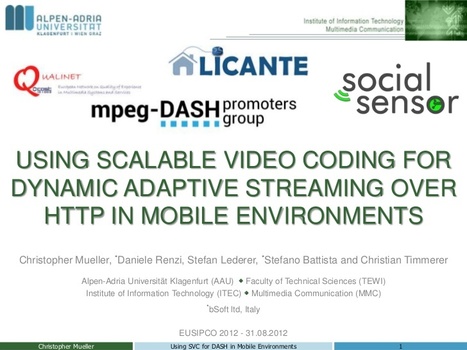 Your new post is loading...
 Your new post is loading...
Since 2012, YouTube has been trying to reduce dramatically the time it takes for a video to start from the moment you press play. Flash Networks (Mobixell at the time) was among the first to detect a new proprietary implementation called sliced bread. The matter might seem trivial, but internal research from Google show that most users find a waiting time exceeding 200ms unacceptable for short videos. YouTube has been developing a proprietary protocol, based on HTTP adaptive streaming DASH to decrease latency and start time for its videos.
Avec le passage au full HD et bientôt à la 4K de a diffusion OTT, le modèle de distribution unicast montre ses limites. La course à l’armement des CDNs dans le déploiement de baies de serveurs et la multiplication des points de peering n’est pas scalable à l’infini, et pourtant le traffic vidéo ne cesse d’augmenter de manière exponentielle, y compris – et surtout – sur les terminaux mobiles. La recherche de modèles de distribution OTT complémentaires avec le multicast est donc une priorité pour continuer d’assurer la qualité de l’expérience utilisateur et optimiser les coûts de diffusion. Les regards se tournent de plus en plus vers le transport multicast qui a fait le succès de l’IPTV, ainsi que le Peer-to-Peer qui, malgré sa réputation sulfureuse, a déjà fait ses preuves pour la diffusion de chaines live OTT à très grande échelle. Pour tout savoir du multicast et du P2P, et apprendre des retours d’expérience et de recherche des membres de la Squad qui travaillent sur ces systèmes hybrides, OVFSquad organisait le 23 janvier 2014 une soirée spéciale de présentations (aka « Conférensquad ») dont voici le compte-rendu et les présentations.
In this post, we are going to dwell on the process of video platform design for ourTogether project. From the technical viewpoint, this project is remarkable by containing the entire content lifecycle, from its creation on mobile devices to distribution and viewing. While designing the platform, we sought to attain solution flexibility and cost-efficiency. With the new video platform you can receive, store and share videos. All video management tasks were implemented on Apple HLS. Problem statement Design a video platform to enable online broadcast. The platform can:
1) Record content from a variety of mobile devices (iOS/Android smartphones and tablets)
2) View content from a variety of devices (MultiScreening) – iOS / Android / PC. An important feature is to enable publishing via a wonky mobile connection, broadcast fault recovery, and broadcast pause. Also great is that in case of a connection failure the content shot is never lost, with broadcasting fully resumed after recovery. Here it is important to ensure that "It just works", regardless of unstable connection issues. In other words, this is a common video camera that can publish your recordings online whatever the bandwidth or connection quality.
Expway has announced the launch of the 5th generation of its Mobile Broadcast software, the eMBMS solution, at the Mobile World Congress 2013. The solution enables Mobile Operators to broadcast any content, live or on-demand, over their LTE network. About the eMBMS Solution : The eMBMS Device Middleware controls the eMBMS LTE modem, receives and decodes the eMBMS streams. It stores or displays the received content through a separate Video Player. The eMBMS DASH Video Player resides next to the Middleware and is used to play all unicast and broadcast video streams compatible with the newly adopted DASH standard. It uses devices hardware acceleration for best performance. The eMBMS BM-SC Server handles the service layer at the eMBMS network, allowing the Carrier to push files and delivers live TV streams, on its LTE network, by using broadcast.
Could the future of broadcasting be wireless broadband? “Big-stick” broadcasting—where you place an antenna atop a tall tower and fling out a megawatt or more of power—may be dying. The advertising economics of an election year will mask eroding TV station advertising margins, but the past 10 years have not been kind to a broadcasting model that had been profitable for decades. There are many reasons why broadcasting doesn’t generate the profits it used to, but there’s no denying that competition from cable operators and telcos is at least one reason. Meanwhile, broadcasters are stuck with their big-stick broadcasting model, while the competition nimbly builds new services and new revenue streams.
Two wireless giants are demonstrating a transmission method similar to one proposed by a U.S. broadcast coalition last fall. Ericsson and Qualcomm unveiled “LTE Broadcast” at the Mobile World Congress 2012 in Barcelona, taking place now through March 1.
“The platform has the potential to significantly reduce operators' costs by allowing them to optimize content and software distribution using broadcast principles over LTE networks,” Qualcomm said. LTE Broadcast leverages the cellular infrastructure in a way that allows it to delivery content to multiple users simultaneously, as opposed to the one-to-one model now used.
A bit more impressions from IBC, Amsterdam. Another hot topic: equipment for mobile broadcasting using wireless networks. It’s some portable device which can be attached to a camera and send audio/video streams to dedicated server installed in broadcasting facility, to CDN etc. The choice is much wider this year; there are a lot of new products. This short review maybe does not include all the solutions shown on IBC, only those of them that I paid attention due some reason and was able to have a closer look.
|
As I begin my journey to this year’s Mobile World Congress in Barcelona, I am thinking through the major trends and inflections that will most impact mobile technology and usage models going forward. One of those I wrote about last week was quick charging. What I would like to talk about now is 4K capabilities on mobile devices and how mobile could be the primary driver for 4K. Let me start with explaining what 4K is and how it applies to mobile devices. I also wanted to touch on some interesting things Qualcomm is doing in this arena.
Flash Networks, the leading provider of mobile Internet optimization and monetization solutions, announced the availability of MPEG-DASH video optimization that reduces network congestion and improves the quality of experience for subscribers without manipulating video content. Flash Networks' MPEG-DASH optimization solution is part of the company's advanced video optimization solution that provides 30%-50% data reduction with no perceptible impact on video quality. Today a significant amount of YouTube traffic is delivered using the MPEG-DASH format. Dynamic Adaptive Streaming over HTTP (DASH), developed under the Moving Picture Experts Group (MPEG), is an open international standard designed to replace multiple vendor solutions to simplify the process of streaming video to the ever-expanding variety of video viewing devices. The companies participating in the MPEG-DASH standardization include Microsoft, Apple, Netflix, Qualcomm, Ericsson, Samsung, and many others. YouTube has implemented a unique flavor of MPEG-DASH that requires more sophisticated methods of optimization than standard MPEG-DASH. Optimization solutions that do not support MPEG-DASH are unable to positively influence the delivery of video with this format and therefore are less efficient overall. Flash Networks, by using proprietary methods, provides an advanced MPEG-DASH optimization solution, enabling mobile operators to provide a more consistent, higher quality of experience to its subscribers. "Providing exceptional video quality is a huge challenge given the varying types of mobile video traffic that need to be optimized," said Ofer Gottfried, Chief Technology Officer at Flash Networks. "At Flash Networks, we continue to invest in research to lead the industry in providing cutting edge mobile video optimization to enable mobile operators to stand out in the crowd and earn lasting subscriber loyalty." Harmony Video Optimization enables operators to optimize video traffic based on various parameters including date and time, network congestion, and subscriber information. Due to highly efficient transcoders and a unique system architecture, Harmony Video Optimization has a low footprint, resulting in a solution that is up to five times more cost-effective than other solutions. Flash Networks does not limit its optimization to a pre-selected list of sites, but sits at the heart of the network, inspecting, identifying, and then optimizing video traffic for a superior browsing experience and maximum data reduction.
Read more here: http://www.sacbee.com/2013/10/22/5841297/flash-networks-the-first-to-boost.html#storylink=cpy /PRNewswire/ --
New end-to-end LTE broadcast solution will revolutionize video delivery in mobile networks and address growing consumer demand for TV Anywhere servicesEnables operators to efficiently launch media services over LTE with Ericsson's unique combination of three new standards: eMBMS, HEVC and MPEG DASHVerizon Wireless to introduce LTE Broadcast for entertainment and sporting events beginning in 2014Leading mobile network operator Telstra to commence trials on its live network in 2013
"Dynamic Adaptive Streaming over HTTP (DASH) is a convenient approach to transfer videos in an adaptive and dynamic way to the user. As a consequence, this system provides high bandwidth flexibility and is especially suitable for mobile use cases where the bandwidth variations are tremendous. In this paper we have integrated the Scalable Video Coding (SVC) extensions of the Advanced Video Coding (AVC) standard into the recently ratified MPEG-DASH standard."
At NAB, the Mobile500 Alliance, one of two competing groups of broadcasters working to make Mobile DTV a reality in the United States, brought a second-generation MDTV system to the convention that melds OTA Mobile DTV reception via an iPad dongle receiver with the social media interactivity of Twitter.
Sling Media Inc. and Broadcom Corp. today announced the integration of the Sling Media SDK into Broadcom’s latest set-top box system-on-a-chip platforms. The collaboration paves the way for manufacturers of STBs and CE devices to offer consumers a solution to enjoy watching their favorite television content wherever they want on whatever device they want, with an Internet connection.
Sling Media’s licensed software ecosystem supported on the Broadcom BCM7425 Dual HD Transcoding MoCA Gateway SoC gives users a full-featured multi-screen, multi-platform viewing solution.
Sling Media’s pioneering placeshifting technology coupled with Broadcom’s leadership in high performance STB platforms enable a wide range of content with a consistent viewing experience for service operators’ customers who demand a simple, high-quality way to watch television on the go.
ON THE SAME TOPIC, SEE : http://www.readwriteweb.com/enterprise/2012/01/the-android-based-hdtv-higher.php
|
 Your new post is loading...
Your new post is loading...
 Your new post is loading...
Your new post is loading...






![Les nouvelles frontières de la diffusion OTT : Multicast & P2P [Conférence OVFSquad] | Video Breakthroughs | Scoop.it](https://img.scoop.it/pOujM-JuMKqsNZVy_hdtAjl72eJkfbmt4t8yenImKBVvK0kTmF0xjctABnaLJIm9)

![Expway eMBMS (DASH compliant) Solution Allows Mobile Operators to off-Load Mobile Traffic by 20% [PR] | Video Breakthroughs | Scoop.it](https://img.scoop.it/SaIHvlMZP6GNWx8GvUfZxjl72eJkfbmt4t8yenImKBVvK0kTmF0xjctABnaLJIm9)



![World's first complete solution for broadcast video over LTE networks with eMBMS, HEVC and MPEG DASH [PR] | Video Breakthroughs | Scoop.it](https://img.scoop.it/CuCiJ1iH0d_4n2ctqxjn9Tl72eJkfbmt4t8yenImKBVvK0kTmF0xjctABnaLJIm9)






